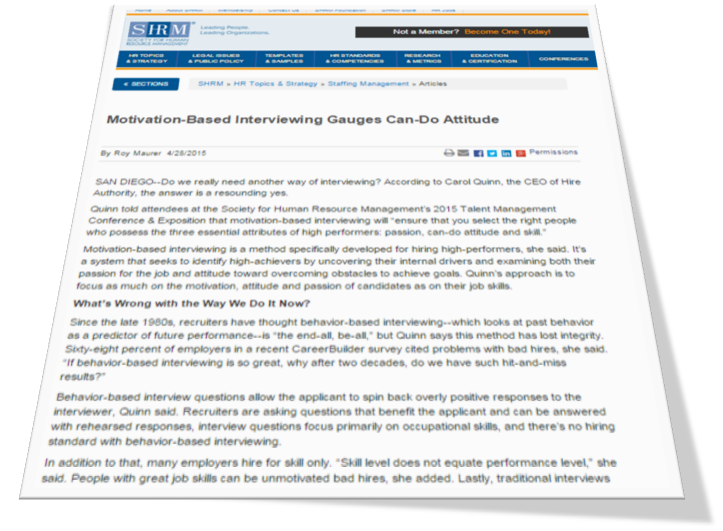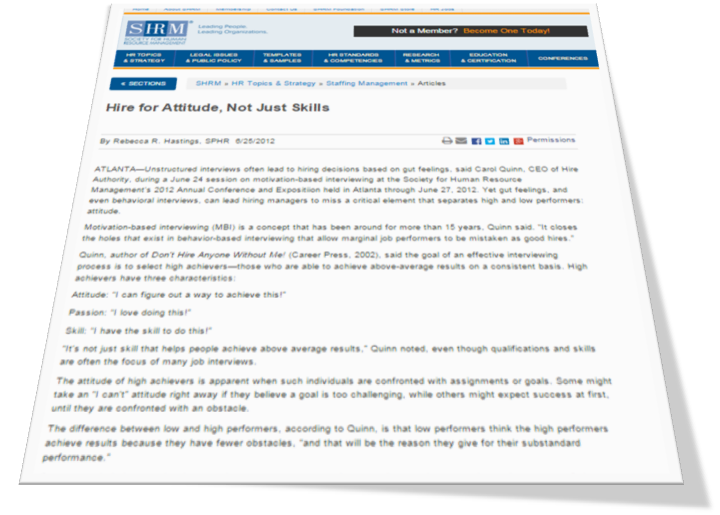Motivation-Based Interviewing Gauges Can-Do Attitude
SAN DIEGO--Do we really need another way of interviewing? According to Carol Quinn, the CEO of Hire Authority, the answer is a resounding yes.
Quinn told attendees at the Society for Human Resource Management’s 2015 Talent Management Conference & Exposition that motivation-based interviewing will “ensure that you select the right people who possess the three essential attributes of high performers: passion, can-do attitude and skill.”
Motivation-based interviewing is a method specifically developed for hiring high-performers, she said. It’s a system that seeks to identify high-achievers by uncovering their internal drivers and examining both their passion for the job and attitude toward overcoming obstacles to achieve goals. Quinn’s approach is to focus as much on the motivation, attitude and passion of candidates as on their job skills.
What’s Wrong with the Way We Do It Now?
Since the late 1980s, recruiters have thought behavior-based interviewing--which looks at past behavior as a predictor of future performance--is “the end-all, be-all,” but Quinn says this method has lost integrity. Sixty-eight percent of employers in a recent CareerBuilder survey cited problems with bad hires, she said. “If behavior-based interviewing is so great, why after two decades, do we have such hit-and-miss results?”
Behavior-based interview questions allow the applicant to spin back overly positive responses to the interviewer, Quinn said. Recruiters are asking questions that benefit the applicant and can be answered with rehearsed responses, interview questions focus primarily on occupational skills, and there’s no hiring standard with behavior-based interviewing.
In addition to that, many employers hire for skill only. “Skill level does not equate performance level,” she said. People with great job skills can be unmotivated bad hires, she added. Lastly, traditional interviews still rely on a gut feeling, Quinn said, and recruiters often end up hiring the person they like or feel comfortable with.
Response to Obstacles Differentiates Candidates
The motivation-based method’s main objective is to determine if a person is a high-achiever or simply an average worker by asking a series of questions that are designed to see how a person handles obstacles. “Achievement is a process,” Quinn said. Does the person approach goals and the obstacles that come with those goals with a can-do, problem-solver attitude or does he or she give up, blaming external factors for failure? Obstacles force a reaction: either I can or I can’t. “Wouldn’t it make sense to hire people who strive to overcome obstacles?” she asked.
“This is such a powerful predictor of future performance because those who go into problem-solving mode overcome their obstacles, and not everyone goes into problem-solving mode,” Quinn said. Excuses and blaming are offered up as a substitute for results. “Blaming external factors for not overcoming obstacles are huge clues for recruiters during an interview,” she said.
Quinn explained that properly phrased skill-assessment questions can be used to gather both skill and attitude information during the interview. From this, the applicant’s predominant response to difficult challenges can be determined.
In addition, specific questions can assess an applicant’s passion. Passion is assessed by determining what motivates the candidate most, and it’s considered the single most powerful natural self-motivator. “Ideally you want a passion-job match,” she said. “For example, the notoriously bad service in the customer service industry is not because of lack of training. It’s hiring people who don’t like to serve customers.”
When the predominant “I can” attitude joins forces with the passion for doing the work, it creates the highest level of self-motivation, Quinn said.
She advised recruiters to incorporate a minimum hiring standard that includes all three of the high-performer components--skill, attitude and passion. “Hiring high-performers is about aligning your selection process with how achievement comes about.”
Roy Maurer is an online editor/manager for SHRM. Follow him @SHRMRoy
Permission to post granted by Roy Maurer. Thank you Roy!
Hire For Attitude, Not Just Skills
Motivation-based interviewing (MBI) is a concept that has been around for more than 15 years, Quinn said. “It closes the holes that exist in behavior-based interviewing that allow marginal job performers to be mistaken as good hires.”
Quinn, author of Don't Hire Anyone Without Me! (Career Press, 2002), said the goal of an effective interviewing process is to select high achievers—those who are able to achieve above-average results on a consistent basis. High achievers have three characteristics:
Attitude: “I can figure out a way to achieve this!”
Passion: “I love doing this!”
Skill: “I have the skill to do this!”
“It’s not just skill that helps people achieve above average results,” Quinn noted, even though qualifications and skills are often the focus of many job interviews.
The attitude of high achievers is apparent when such individuals are confronted with assignments or goals. Some might take an “I can’t” attitude right away if they believe a goal is too challenging, while others might expect success at first, until they are confronted with an obstacle.
The difference between low and high performers, according to Quinn, is that low performers think the high performers achieve results because they have fewer obstacles, “and that will be the reason they give for their substandard performance.”
Only the optimistic “I can” attitude activates the problem-solving part of the brain located in the frontal lobe, Quinn explained. “Problem-solving effort is required to conquer obstacles.”
During the session Quinn showed a video in which a boss gave two managers a week to solve the same business challenge. One manager had a positive attitude about the challenge and worked closely with her team to identify a solution that exceeded the expected result. The other had a negative attitude and failed to meet the boss’s expectation.
MBI involves the assessment of attitude, passion and skill through the use of a structured interview format. Interviewing questions are written to present applicants with an obstacle situation, the action taken and the end results. For example, “Tell me a specific time when you had to deal with an irate customer. What action did you take? What was the end result?”
Hiring for attitude is essential, she noted, because “you are not going to change anybody else’s attitude. You are not going to get into anyone else’s head and re-program them.”
Participants left the session with an MBI interview guide template that included five questions which can be used to assess career fit, including likes, dislikes, strengths, weaknesses and career goals.
HR people are often not the ones doing the interviewing, so they need a process they can use to teach others, Quinn told SHRM Conference Daily. “If you have a complex interviewing process, managers won’t use it.”
Rebecca R. Hastings, SPHR, is an online editor/manager for SHRM.

